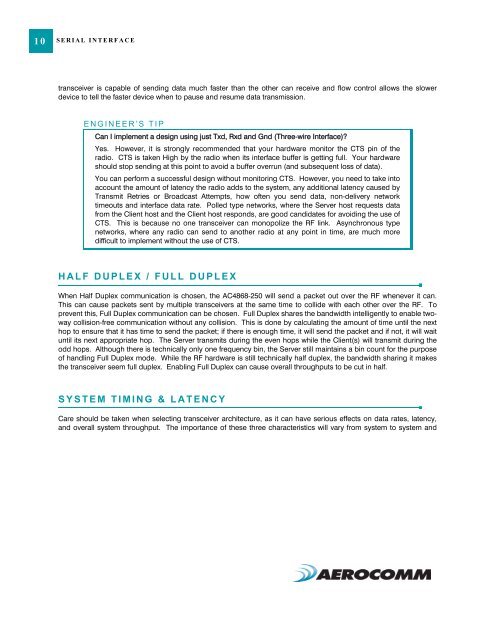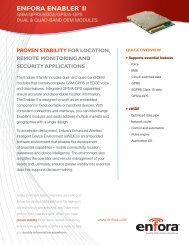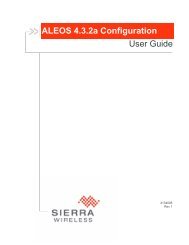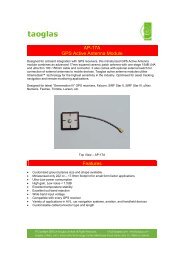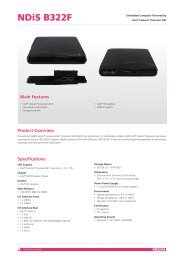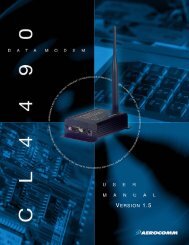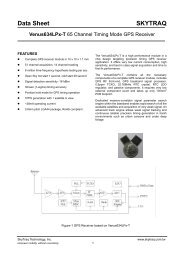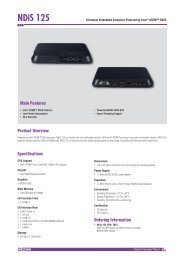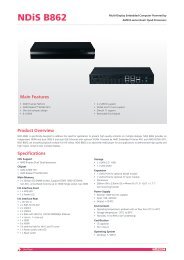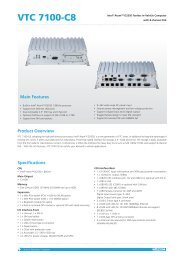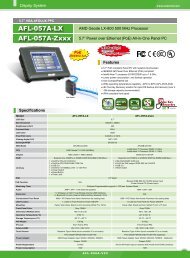Aerocomm AC4868.pdf - HEAnet Mirror Service
Aerocomm AC4868.pdf - HEAnet Mirror Service
Aerocomm AC4868.pdf - HEAnet Mirror Service
You also want an ePaper? Increase the reach of your titles
YUMPU automatically turns print PDFs into web optimized ePapers that Google loves.
10<br />
SERIAL INTERFACE<br />
transceiver is capable of sending data much faster than the other can receive and flow control allows the slower<br />
device to tell the faster device when to pause and resume data transmission.<br />
ENGINEER’S TIP<br />
Can I implement a design using just Txd, Rxd and Gnd (Three-wire Interface)?<br />
Yes. However, it is strongly recommended that your hardware monitor the CTS pin of the<br />
radio. CTS is taken High by the radio when its interface buffer is getting full. Your hardware<br />
should stop sending at this point to avoid a buffer overrun (and subsequent loss of data).<br />
You can perform a successful design without monitoring CTS. However, you need to take into<br />
account the amount of latency the radio adds to the system, any additional latency caused by<br />
Transmit Retries or Broadcast Attempts, how often you send data, non-delivery network<br />
timeouts and interface data rate. Polled type networks, where the Server host requests data<br />
from the Client host and the Client host responds, are good candidates for avoiding the use of<br />
CTS. This is because no one transceiver can monopolize the RF link. Asynchronous type<br />
networks, where any radio can send to another radio at any point in time, are much more<br />
difficult to implement without the use of CTS.<br />
HALF DUPLEX / FULL DUPLEX<br />
When Half Duplex communication is chosen, the AC4868-250 will send a packet out over the RF whenever it can.<br />
This can cause packets sent by multiple transceivers at the same time to collide with each other over the RF. To<br />
prevent this, Full Duplex communication can be chosen. Full Duplex shares the bandwidth intelligently to enable twoway<br />
collision-free communication without any collision. This is done by calculating the amount of time until the next<br />
hop to ensure that it has time to send the packet; if there is enough time, it will send the packet and if not, it will wait<br />
until its next appropriate hop. The Server transmits during the even hops while the Client(s) will transmit during the<br />
odd hops. Although there is technically only one frequency bin, the Server still maintains a bin count for the purpose<br />
of handling Full Duplex mode. While the RF hardware is still technically half duplex, the bandwidth sharing it makes<br />
the transceiver seem full duplex. Enabling Full Duplex can cause overall throughputs to be cut in half.<br />
SYSTEM TIMING & LATENCY<br />
Care should be taken when selecting transceiver architecture, as it can have serious effects on data rates, latency,<br />
and overall system throughput. The importance of these three characteristics will vary from system to system and


